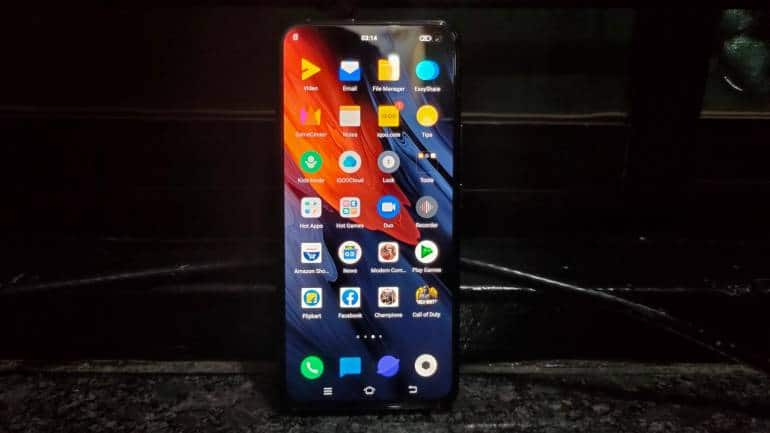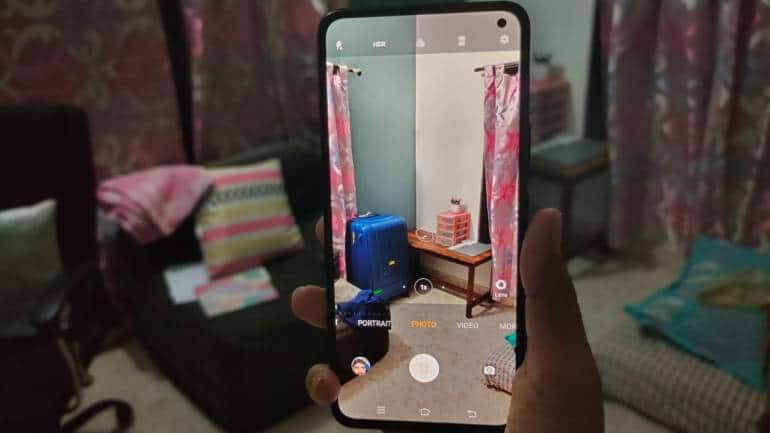



The iQOO 3 was unveiled as India's second 5G smartphone last month. The smartphone arrives in three configurations with the top-tier model offering 5G connectivity. We've had the device for a couple of weeks now and really put the phone through its paces. But before we get into the review, here's a brief introduction of iQOO.
Last year, Vivo launched the iQOO sub-brand in China to capitalise on the gaming smartphone bandwagon. Since then, Vivo iQOO phones have become synonymous with mobile gaming, being able to compete with the best from Asus, Xiaomi, and Nubia, among others. Since the Vivo iQOO, the company has unveiled several iQOO phones in the short span of less than a year.
However, the iQOO 3 is the first phone to launch outside China. iQOO is also operating as an independent brand outside China, following the likes of Realme and Poco. Now, back to the review of the iQOO 3 5G.
iQOO 3 Specifications| Specs | iQOO 3 | iQOO 3 5G |
| Chipset | Snapdragon 865 | Snapdragon 865 |
| Display | 6.44-inch FHD+ Super AMOLED, 60Hz, HDR10+ | 6.44-inch FHD+ Super AMOLED, 60Hz, HDR10+ |
| RAM | 8GB LPDDR5 | 12GB LPDDR5 |
| Storage | 128GB/256GB, UFS 3.1 | 256GB, UFS 3.1 |
| Rear Camera | 48 MP, f/1.8 + 13 MP, f/2.5 (Telephoto) + 13 MP, f/2.2 (Ultrawide) + 2 MP, f/2.4 (Depth) | 48 MP, f/1.8 + 13 MP, f/2.5 (Telephoto) + 13 MP, f/2.2 (Ultrawide) + 2 MP, f/2.4 (Depth) |
| Front Camera | 16 MP, f/2.5 | 16 MP, f/2.5 |
| Software | Android 10; iQOO UI 1.0 | Android 10; iQOO UI 1.0 |
| Battery | 4400 mAh, 55W Fast-Charging | 4400 mAh, 55W Fast-Charging |
| Price (Rs) | 36,990 / 39,990 | 44,990 |
The iQOO 3 5G features a glass body (Corning Gorilla Glass 6) with a metal frame, giving the phone a premium design but putting it on the heavier side. The device arrives in three colours – Quantum Silver, Tornado Black and Volcano Orange. Our unit came in Tornado Black, which seems ordinary if you are into the edgy gradient colour options out there. The Volcano Orange does look promising though.
On the front, the iQOO 3 opts for a punch hole notch for the front camera, while bezels on the screen are slim to the point of being unnoticeable. On the back, the iQOO 3 uses a bigger camera module than any of its predecessor, which looks similar to that of the Galaxy S20. The phone has a dedicated Google Assistant button on the left and the power and volume buttons on the right. iQOO has also incorporated capacitive air triggers on the right, adding extra options for gamers.
DisplayThe iQOO 3 5G sports a 6.44-inch Super AMOLED display with an FHD+ (2,400*1,080) resolution. iQOO opts for a small punch-hole cut out for the front camera with incredibly slim bezels. The phone also gets HDR10+ support and is excellent for content consumption. As compared to other displays in this price range, the iQOO definitely stands out with exceptional levels of brightness and sharpness and just the right amount of saturation.

The one downfall of an otherwise great panel is that it is limited to 60Hz refresh rate, which is a bit of a shame considering similarly priced devices like the OnePlus 7T, OnePlus 7 Pro, Realme X2 Pro and Realme X50 Pro all opt for a higher 90Hz refresh rate. The lack of a high refresh rate display is the only thing holding the iQOO 3 5G's back from being a perfect gaming smartphone. It also has a 180Hz touch sampling rate.
For performance, the iQOO 3 5G packs an Octa-core Snapdragon 865 SoC with the Adreno 650 GPU. The chipset is paired with up to 12GB of RAM and up to 256GB of UFS 3.1 storage, which is an improvement over the current UFS 3.0 storage standards used in most flagship smartphones. Our device was equipped with 12GB of RAM and 256GB of storage.
We ran Call of Duty: Mobile, PUBG Mobile, Asphalt 9, Darkness Rises, and Into the Dead 2. Games ran without a hitch on the iQOO 3 5G; you can crank up the settings to maximum and enjoy excellent graphics and smooth gameplay. The 180Hz touch sampling rate and the game triggers on the top, enhance the mobile gaming experience. Additionally, the 4D vibration motor ensures strong haptic feedback while gaming.
The iQOO 3's Ultra Game mode is automatically turned on when you start a game. The software brings in a slew of new optimisations, including muting notifications, rejecting calls and doing away with interruptions. There's ample scope of customisations and is arguably one of the best game modes we've seen.

We did have a couple of complaints while gaming, which is not a dealbreaker but can be annoying. Firstly, the headphone jack is poorly positioned and tends to be somewhat of an annoyance, but the L-shaped connector does help a bit. Unlike the ROG Phone II, which offered a second USB-C port on the side of the phone to charge it while gaming, the iQOO 3 5G only has one charging port, which also comes in the way while gaming.
We also ran a few benchmarking apps on the iQOO 3 5G to give you a better sense of the performance of this handset. The iQOO 3 5G managed a 5,90,201 score on AnTuTu, which is quite impressive. It also managed a 945 single-core score and 3,401 multi-core score on Geekbench 5's test. In 3DMark Slingshot Extreme OpenGL ES3.1 test, the phone managed an overall score of 7,252 points, while the Sling Shot Extreme Vulkan test saw an overall score of 6,687.
BatteryThe iQOO 3 5G packs a 4,400 mAh battery capacity, which in our experience was more than sufficient to get us through a full day. However, battery management is not the best here. Heavy usage, including gaming, taking photos, streaming videos and browsing the web will cause the phone to die out by evening. But the one saving grace is the 55W fast-charging support, which should fully charge your phone in under 45 minutes.
SoftwareFor software, the handset runs on iQOO UI based on Android 10, which seems like a more polished version of Vivo's FunTouchOS. The UI isn't littered with bloatware (Like FunTouchOS), you do have the option for an app drawer, the animations look pretty good, and there's a decent system-wide dark mode here. The overall software experience is good, but the iQOO 3 5G suffers from the same plight as all Chinese flagship killers, being unable to balance out the hardware and software experience.

When it comes to audio, the iQOO 3 5G has a single mono downward-firing speaker. The placement of the speaker grille makes it pretty easy to muffle while holding the phone. The headphone jack on the device supports Hi-Res audio. The lack of a pair of stereo speakers is a disappointment, but iQOO does offer a pair of wired headphones in the box.
CameraIn terms of optics, the iQOO 3 5G features a quad-camera setup on the back with a 48-megapixel, f/1.8 primary sensor at the helm. You also get a 13-megapixel, f/2.2 ultrawide lens, a 13-megapixel, f/2.5 telephoto shooter and a 2-megapixel, f/2.4 depth sensor. The hole punch notch on the front houses a 16-megapixel, f/2.5 shooter for selfies. Both the front and back cameras support HDR.

The 48-megapixel primary shooter uses pixel-binning by default, churning out images in 12 megapixels. In bright outdoor light, the main camera reproduces images with excellent dynamic range, accurate colour rendition and a good amount of detail. The eye-tracking autofocus works really well. The edge detection algorithms on the iQOO 3 5G don’t always get it right, and portrait shots can either be a hit or a miss.
The iQOO 3 also has an ultrawide camera that will allow you to fit more into your frame, but the reduction in image quality and distortion in the edges are evident. The ultrawide camera can also be used to take macro shots, allowing you to get up close to the subject. Macro shots also yield good detail in the subject.
Lastly, the telephoto camera can do 2x optical zoom and 20x digital zoom. With 2x zoom, results are pretty good, while you can go all the way up to 10x zoom and get usable images but keeping the camera stables gets harder as you go past 5x zoom. Night mode on the iQOO 3 5G is only available on the main camera and results are just about average. Photos shot in low light lack details with the night mode only helping in brightening shadows.

Photos taken on the 16-megapixel front camera deliver pleasing results. Selfies come out sharp, and portrait mode also works well. Additionally, there’s a beautification mode with tons of customisations and HDR is automatically enabled to deliver even better output.
The primary camera can capture 4K video at up to 60 fps and 1080p video at up to 60 fps. The ultrawide camera only supports video in 1080p resolution at 30 fps, while there's a Super Anti-shake mode that offers good stabilisation in 1080p resolution on the main camera. You can also record 1080p video at 30 fps on the front camera. The one shortcoming of recording video is the lack of consistency in colour accuracy when switching between the main, ultrawide, and 2x optical zoom. Recording video in 4K at 60 fps looks good, but there is some aggressive processing here. Footage recorded in low light is certainly not the best and can be unusable at times.

The overall camera experience on the iQOO 3 5G is pretty good if you have the right light. Moreover, selfies on the front camera were surprisingly good both indoors and outdoors. However, consistency across all cameras is non-existent, while low-light performance is sub-par. But these drawbacks aren’t new to flagship phones at these prices.
VerdictThe problem with the iQOO 3 5G is that there is no problem with it. The camera experience does require several improvements and does seem underwhelming even at this price range. But the iQOO 3 offers everything expected of an affordable flagship. You get a decent camera setup in good light, flagship-grade performance, a bright AMOLED display, super-fast charging and premium glass/metal construction.
However, when you consider that the iQOO 3 5G is the company's first smartphone as an independent brand and only the second Snapdragon 865-powered device to arrive in India, it seems just about ordinary. There's nothing about this phone that stands out, and it certainly doesn't live up to the hype.

No doubt it is a good phone and offers excellent value for money, but there's nothing special about it. And that seems like a disappointment considering this was, for the most part, supposed to be India's first 5G smartphone, until Realme pulled the rug out from under iQOO.
Our iQOO 3 unit with 12GB of RAM and 256GB of storage offered 5G connectivity. But other iQOO 3 variants don't support 5G, despite using the Snapdragon 865 SoC. Since 5G is not yet available in India getting the base iQOO 3 model without 5G shouldn't be an issue. However, it does seem silly considering the Realme X50 Pro offers 5G connectivity across all models.
| Pros | Cons |
| Powerful pPerformance | No consistency across all cameras |
| Bright & colour accurate display | Lacklustre software |
| Decent camera in good light | Limited to 60Hz refresh rate |
| Super-fast charging | Poor low light camera performance |
| Shoulder buttons for gaming |

Discover the latest Business News, Sensex, and Nifty updates. Obtain Personal Finance insights, tax queries, and expert opinions on Moneycontrol or download the Moneycontrol App to stay updated!
Find the best of Al News in one place, specially curated for you every weekend.
Stay on top of the latest tech trends and biggest startup news.